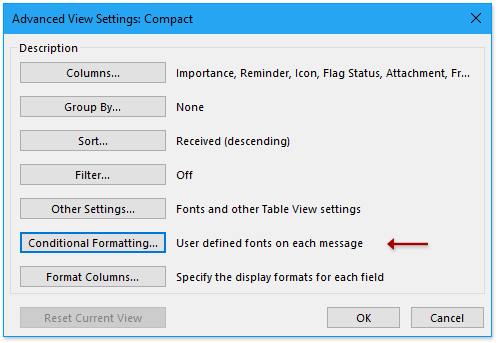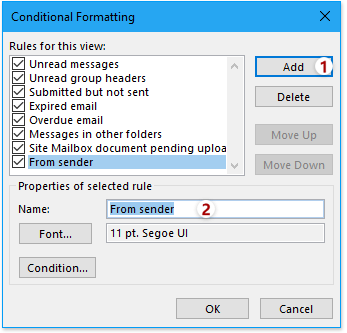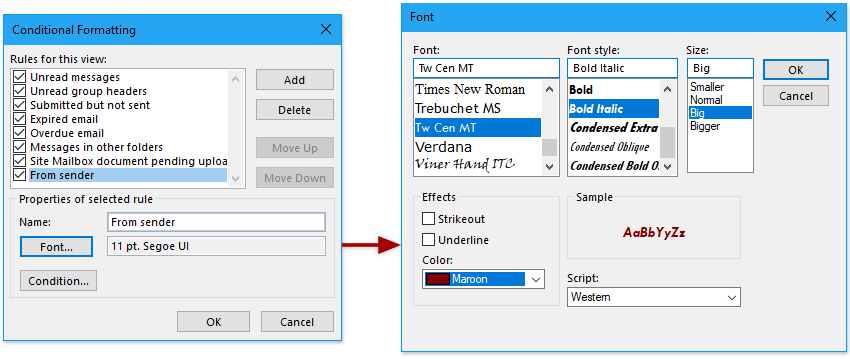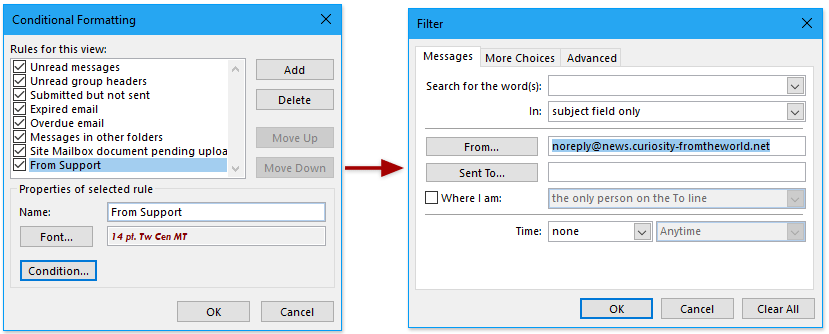Customize current view - conditional formatting
It’s common to use conditional formatting to highlight cells, rows, or columns automatically in Excel. Similar as that in Excel, we can also apply conditional formatting to highlight emails automatically in Outlook. This tutorial will show you how to use conditional formatting in Outlook.
Note: This tutorial is introduced based on exchange account in Microsoft Outlook 2019 desktop program in Windows 10. And it may vary significantly or slightly depending on the types of email accounts (Exchange, IMAP or POP), the versions of Microsoft Outlook, and Windows environments.
Apply conditional formatting to highlight emails automatically
Supposing we need to automatically highlight all emails from a certain sender in the Inbox, we can apply conditional formatting to get it done as follows:
1. After opening the Inbox folder, please click View > View Settings.

2. In the Advanced View Settings dialog, please click the Conditional Formatting button.

3. Now the Conditional Formatting dialog comes out. Please click the Add button, and then type a new conditional formatting rule name in the Name box.

Tips: If you need to modify an existing rule, please click to highlight the rule in the Rules for this view list box.
4. Go ahead to click the Font button in the Conditional Formatting dialog. Then in the Font dialog, please specify the font, font style, font size, font color, etc. as you need, and click the OK button.

5. Go ahead to click the Condition button in the Conditional Formatting dialog. Then in the Filter dialog, please specify the filter criteria as you need, and click the OK button.

Tips: In my case, I type the specified sender’s email address in the From field in the Filter dialog.
6. Click the OK buttons successively to save the settings and close dialogs.
Now in the message list, you will see all emails meeting the specified criteria are highlighted automatically.

Notes
1. You can clear the specified conditional formatting rule as follows: (1) Click View > View Settings; (2) Click Conditional Formatting button in the Advanced View Settings dialog; (3) In the Conditional Formatting dialog, please click to select the conditional formatting rule, and click the Delete button; (4) Click the OK buttons to save changes.

2. You can clear all custom view settings and restore to the default view by clicking View > Reset View.

More articles ...
Best Office Productivity Tools
Kutools for Outlook - Over 100 Powerful Features to Supercharge Your Outlook
🤖 AI Mail Assistant: Instant pro emails with AI magic--one-click to genius replies, perfect tone, multilingual mastery. Transform emailing effortlessly! ...
📧 Email Automation: Out of Office (Available for POP and IMAP) / Schedule Send Emails / Auto CC/BCC by Rules When Sending Email / Auto Forward (Advanced Rules) / Auto Add Greeting / Automatically Split Multi-Recipient Emails into Individual Messages ...
📨 Email Management: Easily Recall Emails / Block Scam Emails by Subjects and Others / Delete Duplicate Emails / Advanced Search / Consolidate Folders ...
📁 Attachments Pro: Batch Save / Batch Detach / Batch Compress / Auto Save / Auto Detach / Auto Compress ...
🌟 Interface Magic: 😊More Pretty and Cool Emojis / Boost Your Outlook Productivity with Tabbed Views / Minimize Outlook Instead of Closing ...
👍 One-click Wonders: Reply All with Incoming Attachments / Anti-Phishing Emails / 🕘Show Sender's Time Zone ...
👩🏼🤝👩🏻 Contacts & Calendar: Batch Add Contacts From Selected Emails / Split a Contact Group to Individual Groups / Remove Birthday Reminders ...
Over 100 Features Await Your Exploration! Click Here to Discover More.

